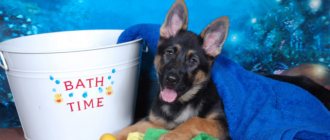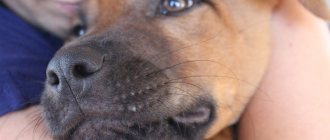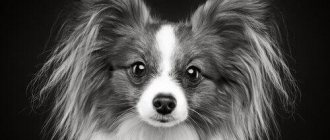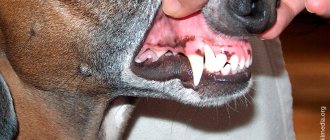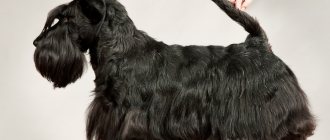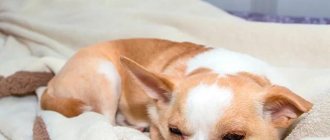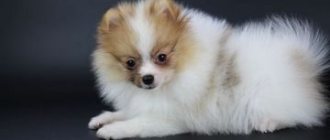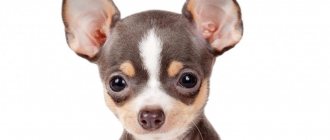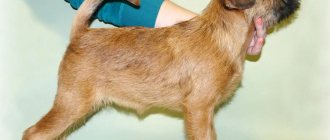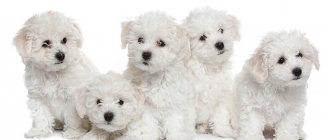When a Chihuahua begins to shed, the dog owner nervously grabs his head. The Chihuahua's fur falls out in clumps, floats around the apartment, and settles on furniture and clothes. Subsequently, adults and children suffer greatly with a severe allergic reaction to animal fur.
It is important to understand that Chihuahuas lose hair all the time, we just don’t notice it. In this way, the dog gets rid of excess and damaged hair. During dry and wet cleaning, accumulations of fallen hair are carefully removed from the living space. But relatively severe hair loss is seasonal.
Seasonal molting and its function
Shedding is a natural physiological process when a dog gets rid of damaged and excess guard hair and undercoat, making room for the growth of new hair. Both long-haired and smooth-haired Chihuahuas shed. And almost to the same extent, so the opinion that smooth-haired Chihuahuas have less hair is wrong.
The Chihuahua's fur consists of guard hairs and down hairs (undercoat). The RKF Chihuahua breed standards allow dogs with a complete absence of undercoat. The absence of fluff occurs in both long-haired and smooth-haired individuals. According to the information received, the coat of Chihuahua dogs is conditionally divided into 2 types:
- single-haired;
- double-coated.
In dogs, fur performs a protective function of the body from climatic influences. It allows you to regulate body temperature within normal values (37.5-39°C). In humans, sweat glands act as a thermostat. Dogs have fur and other means.
For example, when a dog is hot, it quickens its breathing, presses against cool surfaces, and limits physical activity until the body cools down. To keep warm, the Chihuahua hides under a blanket, cuddles up to the radiator, or basks in the open sunlight, while its metabolism slows down.
Shortly before the onset of cold weather, fine guard and down hairs begin to fall out. It is replaced by a thick and warm “fur coat” that prevents heat from escaping, just as clothing insulates human bodies. In the warm season, on the contrary, the hairline becomes thinner and thinner, which slows down the process of absorbing heat from the environment. Thus, the season when Chihuahuas shed heavily is considered to be autumn and spring. Molting lasts 2-3 weeks.
In dogs, like in humans, hair growth is cyclical and consists of 3 phases:
- Anagen (growth): nutrients enter the hair bulb (follicle) through the blood vessels of the dermal papilla, thereby stimulating hair growth.
- Catagen (death): the dermal papilla atrophies, nutrients stop flowing to the root, as a result of which hair growth stops.
- Telogen (loss): the connection between the follicle and the papilla is broken, the hair is pushed to the surface of the epidermis and falls out naturally.
A new hair follicle is formed around the dermal papilla, and the cycle repeats.
There is such a thing as puppy (juvenile) shedding. Chihuahua puppies are born with fluffy and soft fur. The thermoregulation systems of puppies are turned off, so this “fur coat” protects the body from temperature changes. The complete change from puppy coat to adult coarse coat is completed by 5-6 months of life, when the change of milk teeth in a Chihuahua begins. All stages of fur renewal in a puppy are visible to the naked eye.
Choosing a puppy, care, maintenance, education
Before purchasing, be sure to read the description of the breed and the character traits of the beagle. It is recommended to purchase a puppy no older than 1.5-2 months. The sooner a pet appears in the house, the more likely it is that an adult beagle will be obedient. Main selection criteria: origin, appearance, condition of the body.
If the dog is needed for hunting or participating in exhibitions, purchase a beagle from a kennel. A purebred puppy must have a pedigree. Ask to see the documents of the parents; awards and titles indicate the good potential of the offspring. You can take any healthy puppy as a pet. Signs of good health:
- confidence in movements, stability;
- strong paws;
- “luminous” wool;
- eyes are shiny, no discharge;
- active behavior, mobility.
The following items will be required:
- 2 small bowls (preferably metal, on a stand);
- collar, muzzle;
- leash, harness;
- rug or bed;
- mini-aviary;
- carrying;
- toys;
- veined bone;
- tray, disposable diapers for toilet training.
Grooming tools required (brush, fine-toothed comb, nail clipper, shampoo, conditioner). If you take your beagle for hunting, it is recommended to purchase a tracker or Garmin GPS device.
Create a safe environment for the puppy by removing from reach: medicines, food, household chemicals, clothes, wires, valuables. Place your shoes in a closed closet.
Beagle puppies are very curious and stick their noses everywhere. The baby can follow the owner all day long, interfering with homework, so the best place in the apartment would be a mini-aviary with a good view. Place bowls for food and water, a tray, and toys there.
The pet requires a lot of exercise, long walks should be daily. Increase the duration of exposure to air gradually, starting from 5 minutes. Take your dog out only on a leash (harness), walk away from the roadway.
Active games and sufficient physical activity are required; this is part of the main responsibilities for caring for a beagle. Please note that walking around the city will not be enough. A grown dog needs to be regularly taken out into nature (to the forest, field). If this is not possible, play hidden object games.
Maintenance in a country house
During the warm season, it is recommended to keep your beagle outside. The enclosure should be spacious and strong. The beagle should have no chance of getting out. Let him out more often, play with him.
The fence enclosing the territory also needs to be strengthened, otherwise the dog will dig under it. Walking in the yard is not enough; you will need to walk with her in a field or forest. A beagle can easily run up to 10 km per day.
Upbringing
Key conditions for successful parenting: patience, perseverance, confidence, encouragement of correct behavior. You cannot raise your voice, use force, or use physical punishment, otherwise the dog will stop trusting the owner and will be afraid of him. As a result, further learning will become significantly more difficult or impossible.
Start raising your pet from day one. The puppy must distinguish between its toys and its owner's things. You can’t follow the beagle’s lead and give in to him. You cannot first prohibit and then allow the same thing.
Toilet train immediately. Transfer the puppy to the diaper or tray when you notice characteristic restlessness after feeding. At the end of the process, encourage with kind words. When the puppy grows up a little, he will quickly get used to doing his business outside.
Teach your dog to go to the veterinarian without fear and reward good behavior with treats. It is recommended to implant a microchip under the beagle's skin; this increases the chance of finding your pet if it gets lost.
Training
To teach a puppy to obey, training must be done daily. Until four months of age, lessons should not last longer than 5-10 minutes, otherwise the pet will get tired. Start by learning simple commands: “sit”, “paw”, “place”, “come”. Pronounce the words clearly and clearly. It is important that the training is rich and varied.
To socialize your beagle, attend training classes, which will help you develop obedience and appropriate behavior. A puppy aged 3-6 months can be enrolled in a general education course (GEC). After successful completion, complete a general obedience course (OKP), a general training course (OKD). It is very important to work on all the basic commands before your dog goes through puberty.
If the beagle was purchased for hunting, from the age of 8-9 months you can begin training (baiting). Dog training services are provided by hunting clubs.
How do dogs know when it's time to shed?
There is an opinion that the process of changing fur in Chihuahuas is affected by temperature changes in the environment. In fact, the length of daylight hours influences the initiation of the physiological process.
By focusing on the time difference between daylight and darkness, the Chihuahua understands when it is time to shed. These changes regulate the level of melatonin produced by the dog's pineal gland. Melatonin is also called the “hormone of darkness”, because. produced by the body exclusively in the dark.
In other words, the level of melatonin after the spring equinox begins to systematically decrease, because the daily amount of daylight increases. The Chihuahua starts molting, the dog gets rid of excess hair so as not to get heatstroke in a winter “fur coat”.
The autumnal equinox works in reverse. Melatonin levels begin to rise, signaling the body to grow additional fur necessary to retain heat during the cold season. The density of the undercoat and guard hairs increases.
The situation with domestic dogs has destabilized. Artificial light sources negatively affect the animal’s biorhythm. The biological clock is malfunctioning. As a result, there is a violation of the molting schedule. It may begin with a delay or proceed with anomalies. For example, the hair will fall out in whole clumps, forming bald patches.
Health, tendency to disease
The breed is prone to the following diseases:
- Epilepsy. It manifests itself as characteristic attacks, the frequency of which increases with age. Causes: hereditary factor, stress. Consequences: possible injuries during an attack. The disease is incurable, taking medications can reduce the number and duration of attacks.
- Discopathy. Characterized by damage to the intervertebral discs. Reason: violations of water-salt metabolism. Consequences: compression of the spinal cord, which leads to pain, loss of sensitivity, paralysis, fecal and urinary incontinence. Treatment: in mild cases - restriction of mobility for 3-4 weeks by placing in a mini-aviary (cage), prescribing non-steroidal anti-inflammatory drugs. In severe cases, surgical intervention is indicated.
- Stenosis (thinning) of the pulmonary valve. Causes: developmental defect. It is asymptomatic and is detected using ECG and ultrasound. Consequences: heart attack with fatal outcome. Treatment: surgical.
- Infectious and inflammatory lesions of the ears. Reason: structural features (loop ears), which reduce the ventilation of the ear canals, which promotes the proliferation of pathogenic flora. Consequences: dangerous complications (disorders of the vestibular apparatus, inflammation of the meninges). Main symptoms: sharp, unpleasant odor from the ears;
- redness, swelling;
- discharge, crusts inside the ear;
- restless behavior (the beagle shakes its head, scratches its ears, whines).
Treatment: use of special drops; if necessary, a course of antibiotics (tablets or injections) will be required.
- Adenoma of the third eyelid (“cherry eye”). Characterized by prolapse of the third eyelid gland. Consequences: dry eye effect, visual impairment. Treatment: surgical. Sometimes the gland is removed, then the pet will need to regularly instill the “artificial tear” drug.
Causes of excessive hair loss
Seasonal shedding in Chihuahuas proceeds smoothly, so, as a rule, there is no reason for concern. But heavy hair loss, forming bald spots, indicates pathological disorders in the dog’s body. Especially if the animal’s behavior changes dramatically. Possible reasons include:
- poor quality and unbalanced dog diet;
- stress, including that caused by pregnancy, moving to a new home;
- vitamin deficiency due to a lack of vitamins “A” and “B” in the body;
- hormonal imbalance, increased levels of estrogen in the blood;
- food or contact allergies to chemical irritants;
- skin fungal or bacterial infection (ringworm, pyoderma);
- worms, fleas, parasitic mites (skin disease - demodicosis);
- dry skin, itching, rash and flaking (dandruff);
- basal cell carcinoma (carcinoma, basal cell carcinoma, epithelioma).
Alopecia requires an immediate visit to your veterinarian to diagnose the cause of hair loss in your Chihuahua. Entrust the work to a specialist, do not self-medicate! Especially if baldness is accompanied by the following behavioral symptoms:
- aggressive or anxious behavior;
- painful reaction to stroking;
- redness and rashes on the skin;
- refusal of food and drinking water;
- apathetic state, lethargy;
- increased body temperature;
- vomiting, diarrhea, heavy breathing.
Professional breeders note that during pregnancy and nursing puppies, the female Chihuahua sheds heavily. The reason is caused by hormonal stress and is not a pathology!
Likely consequences
All of the above types of shedding are normal and do not require outside intervention. But if your pet is shedding hair at the wrong time or this process occurs in some unusual way (for example, the dog is itching), you should not exclude possible health problems. The reasons for unscheduled molting may be the following:
- improper diet leading to vitamin deficiency, especially lack of vitamins A and B;
- low quality feed;
- diseases related to the kidneys, liver or heart;
- hormonal disorders;
- the presence of parasites in the intestines, fleas and ticks on the skin;
- allergies to certain foods and feeds;
- use of low-quality shampoos and sprays for hair care;
- overheating caused by wearing too warm clothes or being in a hot place;
- too frequent water procedures;
- stress caused by rough treatment, departure of the owner, etc.
Caring for Chihuahua fur during shedding
Daily brushing of a Chihuahua's coat during shedding is one of the most important care requirements. It promotes the mechanical removal of dead hairs that prevent the growth of new ones. In addition, combing prevents the formation of tangles - an ideal environment for the proliferation of pathogens.
You can use specialized metal combs, slickers, and brushes to remove shedding hair from your dog's coat. I suggest purchasing a more effective and versatile tool at the pet store - a furminator. The seller will help you choose a furminator based on the type of coat (long, short) of your pet. Price: from 1500 rubles.
Bathe your Chihuahua regularly - once every 2 weeks with protein shampoo. Bathing cleanses the dog's coat of dirt, excess oil, dandruff and other debris. Remember that the process can cause pain to the animal, so comb the fur carefully, along the hair growth.
If possible, massage warm coconut oil into your dog's skin after the bath. Give your pet a small teaspoon of salmon oil (with food) for oral administration. Salmon oil is rich in fatty acids necessary for the nutrition and maintenance of the health of the dog's external integument. Rub coconut oil exclusively!
Feeding the puppies
Ready-made feed
Dry food for puppies. Select your daily calorie intake and serving size, taking into account your age and activity level. If the puppy begins to gain weight or has a tendency to diarrhea, reduce the size of the portions. The baby is up to 3-3.5 months old. Give pre-soaked food. The puppy should always have access to a bowl of water.
Natural nutrition
Diet composition: 70% - meat (veal, beef, chicken, turkey), 30% - other food, which includes:
- porridge (rice, buckwheat, oatmeal);
- fermented milk drinks, products (kefir, fermented baked milk, cottage cheese);
- vegetables (carrots, zucchini, beets, cauliflower, pumpkin);
- fruits (apples, bananas, pears).
Cut the meat into pieces, cook a little or scald with boiling water. It is given in its raw form starting from 3 months. Cook porridge in water, broth (fish, meat, vegetable). Before feeding, add vegetables (boiled, raw), sour cream or vegetable (butter) oil.
Feed food warm. Give vitamin and mineral supplements regularly. Since beagles have increased stress on their bones, calcium supplements are helpful. It is better to mix additives with fermented milk.
Additionally:
- Meat can be replaced with boiled offal (give no more than 3 times a week).
- Be sure to remove the skin from poultry meat.
- Bones (except tubular), cartilage – 1 rub. per week (as a treat).
- Eggs (boiled) – no more than 2 pieces. in Week.
- Boiled sea fish without bones - 1 rub. per week
- As treats, give dry cookies, unsweetened crackers, pieces of hard cheese.
Prohibited:
- pearl barley, barley, corn grits, millet (poorly digested);
- fatty meat (pork, duck);
- River fish;
- flour, sweet;
- fried, fatty;
- smoked, spicy, salted.
How to get rid of dog hair in the house
A shedding Chihuahua causes its owner a lot of inconvenience. Falling hairs stick to clothes, upholstered furniture, rugs and paths. It’s also not a good idea to get dog hair in your food. It is impossible to completely get rid of lost hair in an apartment, but the following recommendations will help reduce their accumulation to a minimum:
- make it a habit to brush your Chihuahua not only during the molting period, but also regularly (2-3 times a week);
- to remove wool from floor coverings and furniture, use a vacuum cleaner with an electric brush, or a specialized rubber glove for combing;
- clean clothes using a sticky roller brush to remove lint and lint;
- do wet and dry cleaning at least 2 times a week;
- The robot vacuum cleaner does a good job cleaning the floor.
It is possible that you did not find the answer to your question in the article. If so, watch the video below.
It is also useful for you to know: How to understand the reason why a Chihuahua puppy is constantly itching? Why do Chihuahua dogs tremble for no apparent reason?
Brief characteristics of the breed
Males:
Bitches:
How much are:
Life expectancy: 12-15 years. |
What is the difference between a beagle and a beagle harrier? | The Beagle Harrier is a breed of hound, bred in France by crossing the Beagle and the Harrier (a close relative of the English hound breeds, intended for hunting hares). The Beagle Harrier is larger (height at the withers - 45-50 cm), characterized by endurance, a well-developed sense of smell, and quick reaction. |
Who are beagles suitable for? | Energetic people with an active lifestyle, leading a healthy lifestyle, and having experience interacting with dogs. Not suitable for homebodies or those who are too busy. |
Does a puppy's color change as it ages? | Yes, in older beagles the black markings partially turn red. |
Do Beagles Shed? | Yes. Due to the short fur, shedding sometimes goes unnoticed. Beagles shed more in the spring than in the fall. During these periods, comb it out more often with a brush or a special glove. |
What difficulties can there be in parenting? | Beagles are naturally disobedient (especially when walking), stubborn, and therefore difficult to train. Classes should start as early as possible, there should be physical activity. This breed is not for beginners; the beagle requires attention and a special approach. Parenting requires patience and perseverance. |
How to stop a beagle from chewing things? | Beagles need to be trained from puppyhood. Walk and play with him more often. Remove items from the access area that could be damaged by the dog's teeth (shoes, etc.). Limiting the space with a mini-aviary will help. Place more items there that can be chewed (branches, peeled carrots, etc.). |
Is it possible to give bones? | Yes, but only occasionally. Let's have some beef bones. Tails and cartilage are useful. Tubular bones (for example, chicken bones) are prohibited; they split into sharp parts and can injure the gastrointestinal tract. |
Why is it not recommended to let your beagle off the leash while walking? | An untrained beagle may run away if it gets carried away by smells or chases a cat. In the heat of the hunting excitement, he simply will not hear the owner. |
Advantages
- Noble appearance, small (compact) size.
- Good tolerance to physical activity.
- High degree of adaptability to any environment.
- Well developed hunting instincts.
- Impeccable sense of smell.
- No tendency towards aggression.
- Sociability, friendliness.
- Cleanliness, neatness.
- Unpretentiousness in food.
- The wool does not require special care, does not smell, and almost does not shed.
- Excellent companions for children.
Flaws
- Stubbornness, cunning, absent-mindedness.
- Tendency to obesity, requires careful monitoring of diet.
- They can run away if the relationship with the owner does not work out.
- They are prone to wandering, walking mainly on a leash.
- They are very trusting and easily make contact with strangers (the dog can be stolen).
- No guard qualities.
- They can chew things, bark long and loudly, and howl.
- They will not be able to get along with cats, rodents, or birds.
- In the absence of attention, proper education, and physical activity, the dog’s character is irreparably damaged and the dog becomes inadequate.
- Training is required, starting from an early age. Difficulties often arise during training.
Where, first of all, do we start the fight against molting?
What to do if your Chihuahua sheds too often?
If you notice problems with hair loss in your Chihuahua, before you panic, try some tips from pet grooming professionals:
- cosmetic care products should be selected not only according to coat type, but also according to skin type;
- You only need to wash your dog two to three times a year, with the exception of periods of heavy soiling or, for example, preparation for a show;
- Long-haired Chihuahuas need to be brushed every other day, and short-haired ones twice a week;
- When feeding, use only fresh foods, not forgetting about vitamins. When feeding ready-made food, the food must be exclusively premium and suitable specifically for your pet;
- It is mandatory to deworm Chihuahuas every three months;
- Once every six months you need to take tests (general and biochemical blood tests, as well as an analysis for the presence of parasites).
If, despite all these conditions being met, problems with the coat continue, then you need to seek professional help from a veterinarian.
All dog owners are faced with the phenomenon of hair loss in their pets. Like any other dogs, Chihuahuas shed – this is a normal natural process. Of course, during this period more careful care is needed for the baby’s fur.
If your pet seems to be losing too much fur, it could be the result of a medical condition. Let's talk about how to properly care for a Chihuahua's hair during the molting period, how to recognize the symptoms of possible problems and deal with them.
Diagnostic methods
The main and most accurate method for detecting gastroesophageal reflux disease is esophagogastroduodenoscopy. This technique is an endoscopic examination of the mucous membrane of the esophagus using a special probe, at the end of which there is a camera. Information from the camera is transmitted to the monitor and assessed by the doctor in real time. During the study, it is possible to identify foci of the inflammatory process on the mucous membrane, the presence of erosions and ulcers, hiatal hernias, polyps, strictures, as well as foci of malignant degeneration.
To assess the contractility of the lower esophageal sphincter, a functional study such as manometry is used. If a disease such as Barrett's esophagus is suspected, it is recommended to perform gastroscopy with the collection of fragments of the mucous membrane (biopsy). Less often, radiography is used to diagnose GERD. This diagnostic procedure does not reveal pathological changes in the mucous membrane of the esophagus, with the exception of ulcers and hernias.
Varieties
Based on body type, Chihuahuas are divided into two types, cobby and dir , dogs of these types have differences among themselves.
Cobby type features:
- Big head;
- Wide distance between eyes;
- Small, but wide at the base of the ears;
- Volumetric chest;
- Short legs;
- Thick tail;
- Thick hair;
- Massive neck.
Deer type features:
- The head is small;
- The ears are large;
- Long muzzle;
- Not a large chest;
- Relatively long legs;
- The coat is not thick;
- Long and thin tail.
Chihuahuas are also divided according to their size; in general, there are four such subspecies:
You can also divide Chihuahuas by color, which can be absolutely anything. There are even dogs with a combination of coat colors. Well, the main subspecies of Chihuahuas are long-haired and smooth-haired.
Important: Dogs weighing more than 3 kg or less than 500 g are considered disabled.
Historical reference
Country of origin: UK. It is believed that the animals were brought from Ancient Rome. The first reliable information about them dates back to the 16th century; Dogs like beagles were popular under Elizabeth I. They were used for hunting. The modern breed was developed from these hounds. The first Beagle Club in England appeared in 1890, but the official standard was approved in 1957.
Today the breed is most popular in the United States. Beagles are versatile and perfect for the role of a pet. In addition, in Europe they are used to hunt pheasants, foxes, hares, and in Australia - kangaroos. In some European countries, beagles help government officials search for drugs, explosives and other dangerous goods. They are also used by psychologists: communication between a patient and a dog promotes relaxation, improves mood, and improves well-being.
Representatives of the breed appeared in Russia in 1740 through the efforts of Ambassador Ivan Shcherbatov. They did not gain popularity. In the USSR, a club of beagle lovers was created in the 80s. The dogs were taken from the vivarium of the Academy of Medical Sciences, where they were brought from Czechoslovakia for the purpose of laboratory research. According to the breed standard, the animals had disadvantages: a head with a narrow muzzle, an overly stretched body, and a low-set tail.
High-breed dogs appeared in the country in the 90s, but the trend towards an increase in the number of dogs began only in the 2000s. Currently, the breed is most popular in St. Petersburg. In the Russian Federation, beagles are used for hunting and help border guards, customs officers, and police officers in their work.
The history of the appearance of long-haired Chihuahuas
The history of the Chihuahua goes back several centuries. Their homeland is Mexico, so the breed got its name from the state of Chihuahua, where the dogs were first discovered. For a long time they lived in the wild, they were greatly valued by the Mayan Indians, and later the Americans liked the dogs and were exported to the USA and Europe. As a result of selection work, the breed decreased in size and was divided into two types - short-haired and long-haired. At the end of the 19th century, the first exhibition took place where Chihuahuas were presented to the general public. From that time on, they began to quickly spread throughout the world and in 1959 they entered Russia as a gift to N. Khrushchev from F. Castro.
Breed standard according to the FCI system (Federation Cynologique Internationale)
| Head | Voluminous, not coarse, in bitches it is more refined. The skull is moderately wide and rounded. |
| Muzzle | Not pointed, moderately pendulous jowls. |
| Jaws | Strong, scissor bite (upper incisors tightly overlap the lower ones). |
| Eyes | They are planted shallowly, but do not protrude. The color is nut or dark brown. |
| Ears | Set low, tips rounded; long, if pulled out, they reach the tip of the nose; fit tightly to the cheeks. |
| Neck | Slightly curved, there may be a slight dewlap under the throat. |
| Frame | The top is straight and level. The chest drops to the elbows. The loin is flexible, muscular, and short. The stomach is slightly tucked. |
| Forelegs | Located vertically, straight. Pasterns are strong and short. |
| Hind limbs | The thighs are muscular and wide. The lower legs are long, the hock joints are well defined. Hocks are short. |
| Tail | Set on high, of moderate length; does not twist onto the back, does not fall forward (from the base). |
| Wool | Dense, short. The guard hairs are long and strong. There is undercoat. |
| Color | Any characteristic of dogs of hound breeds (except liver). Standard color combination: red, white, black (tricolor). In the UK, bicolor is popular: a combination of white and reddish shades. The tip of the tail should be white. |
| Movements | A sweeping trot with a free step. The forelimbs should not braid or rake, and the hind limbs should not come close. |
| Flaws | Any deviations from the Beagle breed standard. |
